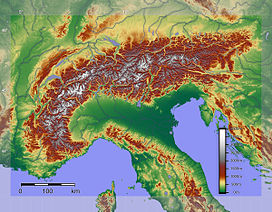
Back Alpe Afrikaans Alpen ALS አልፕስ ተራሮች Amharic Alpes AN Alpis ANG ऐल्प्स ANP الألب Arabic الب ARZ এল্পছ Assamese Alpes AST
| Alps | |
|---|---|
 Satellite view of the Alps | |
| Highest point | |
| Peak | Mont Blanc |
| Elevation | 4,808.73 m (15,776.7 ft)[1] |
| Listing | List of mountain ranges |
| Coordinates | 45°49′58″N 06°51′54″E / 45.83278°N 6.86500°E |
| Dimensions | |
| Length | 1,200 km (750 mi) |
| Width | 250 km (160 mi) |
| Area | 200,000 km2 (77,000 sq mi) |
| Naming | |
| Native name | |
| Geography | |
 Relief of the Alps. See also map with international borders marked. | |
| Countries | |
| Range coordinates | 46°35′N 8°37′E / 46.58°N 8.62°E |
| Geology | |
| Orogeny | Alpine orogeny |
| Rock age | Tertiary |
| Rock types | |

The Alps (/ælps/)[a] are one of the highest and most extensive mountain ranges in Europe,[b][2] stretching approximately 1,200 km (750 mi) across eight Alpine countries (from west to east): Monaco, France, Switzerland, Italy, Liechtenstein, Germany, Austria and Slovenia.[c][4]
The Alpine arch extends from Nice on the western Mediterranean to Trieste on the Adriatic and Vienna at the beginning of the Pannonian Basin. The mountains were formed over tens of millions of years as the African and Eurasian tectonic plates collided. Extreme shortening caused by the event resulted in marine sedimentary rocks rising by thrusting and folding into high mountain peaks such as Mont Blanc and the Matterhorn.
Mont Blanc spans the French–Italian border, and at 4,809 m (15,778 ft) is the highest mountain in the Alps. The Alpine region area contains 128 peaks higher than 4,000 m (13,000 ft).
The altitude and size of the range affect the climate in Europe; in the mountains, precipitation levels vary greatly and climatic conditions consist of distinct zones. Wildlife such as ibex live in the higher peaks to elevations of 3,400 m (11,155 ft), and plants such as edelweiss grow in rocky areas in lower elevations as well as in higher elevations.
Evidence of human habitation in the Alps goes back to the Palaeolithic era. A mummified man ("Ötzi"), determined to be 5,000 years old, was discovered on a glacier at the Austrian–Italian border in 1991.[5]
By the 6th century BC, the Celtic La Tène culture was well established. Hannibal notably crossed the Alps with a herd of elephants, and the Romans had settlements in the region. In 1800, Napoleon crossed one of the mountain passes with an army of 40,000. The 18th and 19th centuries saw an influx of naturalists, writers, and artists, in particular, the Romanticists, followed by the golden age of alpinism as mountaineers began to ascend the peaks of the Alps.
The Alpine region has a strong cultural identity. Traditional practices such as farming, cheesemaking, and woodworking still thrive in Alpine villages. However, the tourist industry began to grow early in the 20th century and expanded significantly after World War II, eventually becoming the dominant industry by the end of the century.
The Winter Olympic Games have been hosted in the Swiss, French, Italian, Austrian and German Alps. As of 2010,[update] the region is home to 14 million people and has 120 million annual visitors.[6]
- ^ "Le Mont-Blanc passe de 4.810 mètres à 4.808,7 mètres". bfmtv.com (in French). Archived from the original on December 26, 2018. Retrieved May 24, 2023.
- ^ "Alps". The Hutchinson unabridged encyclopedia with atlas and weather guide. Abington, United Kingdom: Helicon. 2014. Archived from the original on August 30, 2018. Retrieved March 7, 2015.
- ^ kutka, petr (February 21, 2022). "Víte, že jsou Alpy i v Maďarsku? Geografická zajímavost a tip na příjemný výlet". Světoběžník.info (in Czech). Archived from the original on December 20, 2022. Retrieved April 12, 2022.
- ^ "The Alpine Convention". Alpine Convention. Archived from the original on October 22, 2023. Retrieved July 27, 2023.
The Alps are a fascinating and spectacular mountain range spanning eight countries: Austria, France, Germany, Italy, Liechtenstein, Monaco, Slovenia, and Switzerland.
- ^ "Ötzi the Iceman". www.iceman.it. Archived from the original on October 1, 2023. Retrieved May 24, 2023.
- ^ Chatré, Baptiste, et al. (2010), 8
Cite error: There are <ref group=lower-alpha> tags or {{efn}} templates on this page, but the references will not show without a {{reflist|group=lower-alpha}} template or {{notelist}} template (see the help page).